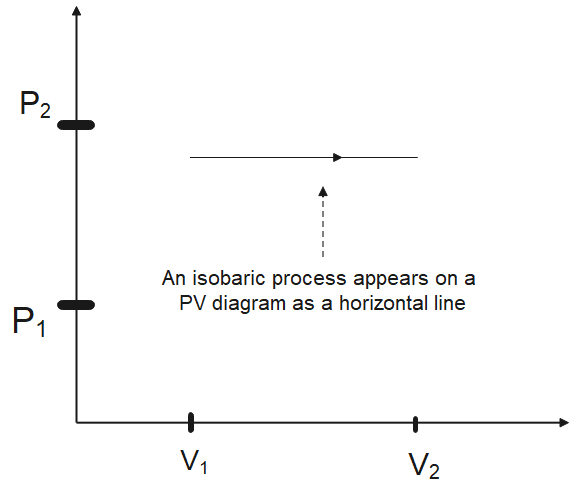
In an Isobaric process, the pressure is constant; means the piston is fixed, so then how work is done?
Answer
448.8k+ views
Hint: An Isobaric process is a thermodynamic process happening at constant pressure. The term isobaric has been derived from the Greek words “iso” and “baros” meaning equal pressure. As such, the constant pressure is obtained when the quantity is expanded or contracted. This basically neutralizes any pressure change because of the transfer of heat.
Complete answer:
In an isobaric process, when the heat is transferred to the system some work is completed. However, there's also a change within the internal energy of the system. This further means no quantities as within the first law of thermodynamics become zero.
The isobaric process is often represented as an isobaric expansion and an isobaric compression. An isobaric expansion is change of state within a system representing a constant pressure and a rise in volume. An isobaric compression represents a constant pressure and a decrease in volume.
The heat transferred to the system does work, but also changes the internal energy (U) of the system.
If the cylinder is warmed, the gas will expand and push the piston up. But the pressure, determined by mass M, won't change. This process is shown on the P – V diagram

Hence, the work done in an isobaric process is due to the change in internal energy and heat transfer.
Note:
The work found through this experimental process is often utilized in the primary law of thermodynamics. expansion. As isobaric compression occurs if the gas is cooled, lowering the piston. An isobaric process appears on a P – V diagram as a horizontal line. The work produced or removed from the system is represented by the world under the curve
Complete answer:
In an isobaric process, when the heat is transferred to the system some work is completed. However, there's also a change within the internal energy of the system. This further means no quantities as within the first law of thermodynamics become zero.
The isobaric process is often represented as an isobaric expansion and an isobaric compression. An isobaric expansion is change of state within a system representing a constant pressure and a rise in volume. An isobaric compression represents a constant pressure and a decrease in volume.
The heat transferred to the system does work, but also changes the internal energy (U) of the system.
If the cylinder is warmed, the gas will expand and push the piston up. But the pressure, determined by mass M, won't change. This process is shown on the P – V diagram

Hence, the work done in an isobaric process is due to the change in internal energy and heat transfer.
Note:
The work found through this experimental process is often utilized in the primary law of thermodynamics. expansion. As isobaric compression occurs if the gas is cooled, lowering the piston. An isobaric process appears on a P – V diagram as a horizontal line. The work produced or removed from the system is represented by the world under the curve
Latest Vedantu courses for you
Grade 11 Science PCM | CBSE | SCHOOL | English
CBSE (2025-26)
School Full course for CBSE students
₹41,848 per year
Recently Updated Pages
Master Class 9 General Knowledge: Engaging Questions & Answers for Success

Master Class 9 English: Engaging Questions & Answers for Success

Master Class 9 Science: Engaging Questions & Answers for Success

Master Class 9 Social Science: Engaging Questions & Answers for Success

Master Class 9 Maths: Engaging Questions & Answers for Success

Class 9 Question and Answer - Your Ultimate Solutions Guide

Trending doubts
State and prove Bernoullis theorem class 11 physics CBSE

Who built the Grand Trunk Road AChandragupta Maurya class 11 social science CBSE

1 ton equals to A 100 kg B 1000 kg C 10 kg D 10000 class 11 physics CBSE

State the laws of reflection of light

One Metric ton is equal to kg A 10000 B 1000 C 100 class 11 physics CBSE

Difference Between Prokaryotic Cells and Eukaryotic Cells




